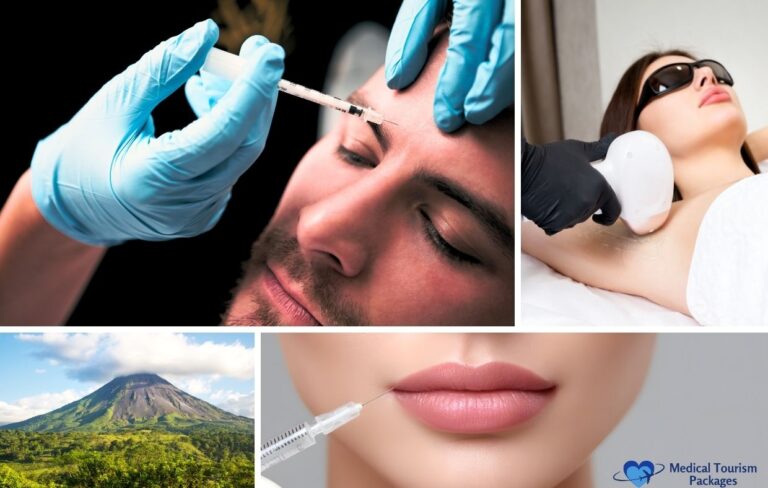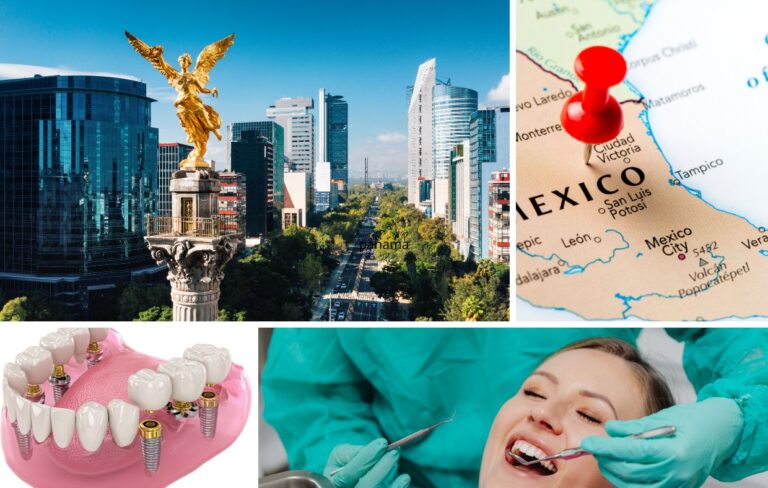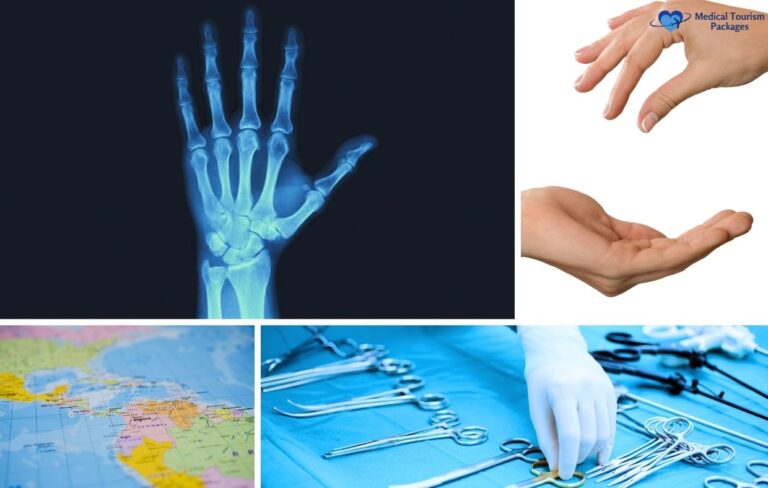Book Appointment Now
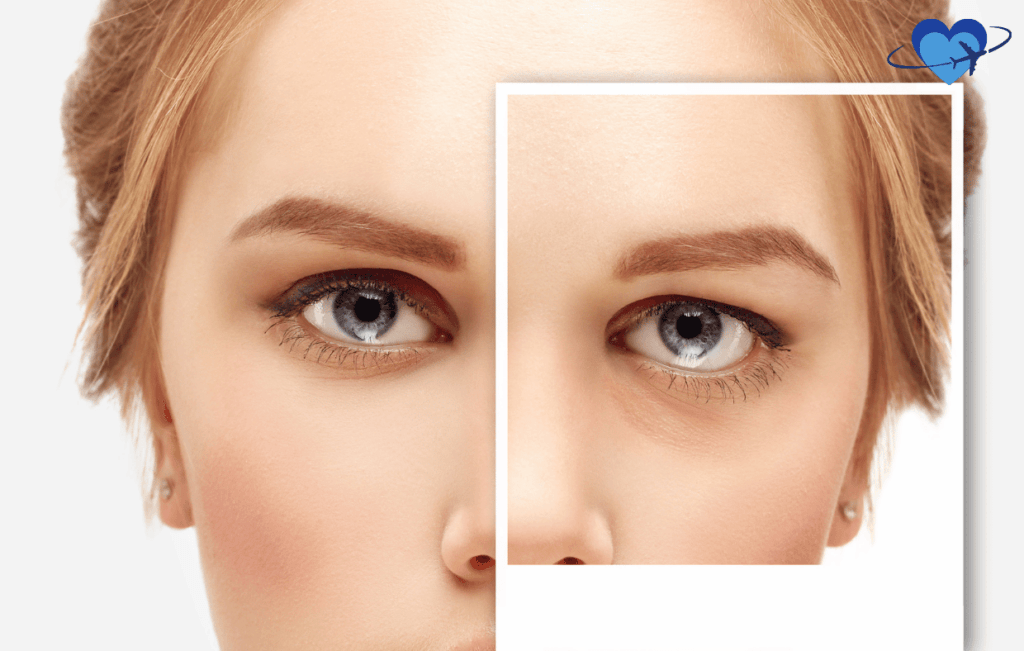
Eye lift (aka Blepharoplasty) in Colombia: Surgery, Recovery, Results
If you’re considering an eye lift or aiming to enhance peripheral vision, Colombia stands out as a key destination for blepharoplasty. This cosmetic surgery, focused on rejuvenating the eyelids, has positioned Colombia as a top choice due to its affordable healthcare, skilled surgeons, and advanced medical facilities.
Blepharoplasty involves removing excess skin, muscle, or fat to create a more youthful look or improve vision. Colombia’s medical tourism sector is thriving, offering quality services at lower costs. The country’s reputation for expert care, combined with its cultural appeal, attracts patients worldwide seeking cosmetic surgery. Here’s an overview of why Colombia is a preferred location for blepharoplasty, including the procedure, recovery, and expected outcomes.
What is eye lift surgery (blepharoplasty procedure) in Colombia?
Eye lift surgery, or blepharoplasty, is a cosmetic procedure performed to enhance the appearance of the eyelids. In Colombia, this surgery aims not only to rejuvenate the area around the eyes by removing excess skin, muscle, and sometimes fat but also to improve peripheral vision obstructed by droopy eyelids. Colombia has emerged as a prime destination for this procedure, offering a blend of affordable healthcare solutions, highly qualified surgeons, and state-of-the-art medical facilities.
What causes drooping eyelids and eye bags?
Let’s be honest – nobody likes looking tired when they’re not. As we get older, gravity isn’t exactly our friend. The delicate skin around our eyes loses its bounce, and before you know it, you’re dealing with drooping eyelids and those pesky fat bags underneath.
Here’s what’s actually happening: The muscles supporting your eyelids weaken over time. Fat that normally cushions your eye can push forward, creating those puffy fat pockets. Add in some wrinkles from years of smiling and squinting, plus sagging skin that just won’t snap back like it used to, and you’ve got yourself a recipe for looking perpetually exhausted.
Some folks develop ptosis – that’s when your upper eyelid actually drops down over your eye. In severe cases, patients might have dermatochalasis, where excess skin literally hangs over the lashes. Colombian surgeons see these conditions all the time and know exactly how to fix them without making you look like you’ve had “work done.”
Colombian surgical facilities – better than you’d expect
Forget what you’ve heard about medical tourism horror stories. Colombia’s state-of-the-art facilities put some U.S. hospitals to shame. We’re talking about places with operating rooms that look like they belong in a sci-fi movie – complete with laminar airflow systems and 4K surgical cameras.
The top clinics in Bogotá have the same equipment you’d find at Johns Hopkins or Mayo Clinic. El Tesoro Medical Tower in Medellín? It’s basically the Four Seasons of surgical centers. These aren’t back-alley operations – they’re legitimate medical facilities where local millionaires get their work done too.
What surprised me most during my research was how many Colombian surgeons trained at places like Harvard and Stanford. They’re not just doing basic procedures either – we’re talking advanced facial plastic surgery techniques that some U.S. doctors haven’t even learned yet.
What are the benefits of undergoing an eye lift in Colombia?
Undergoing an eye lift in Colombia offers numerous benefits, key among them being cost-effectiveness and access to highly skilled surgeons. Patients are drawn to Colombia not just for the affordable prices compared to those in North America and Europe, but also for the high-quality medical care. The country boasts advanced medical facilities that adhere to international standards, ensuring that patients receive top-notch care.
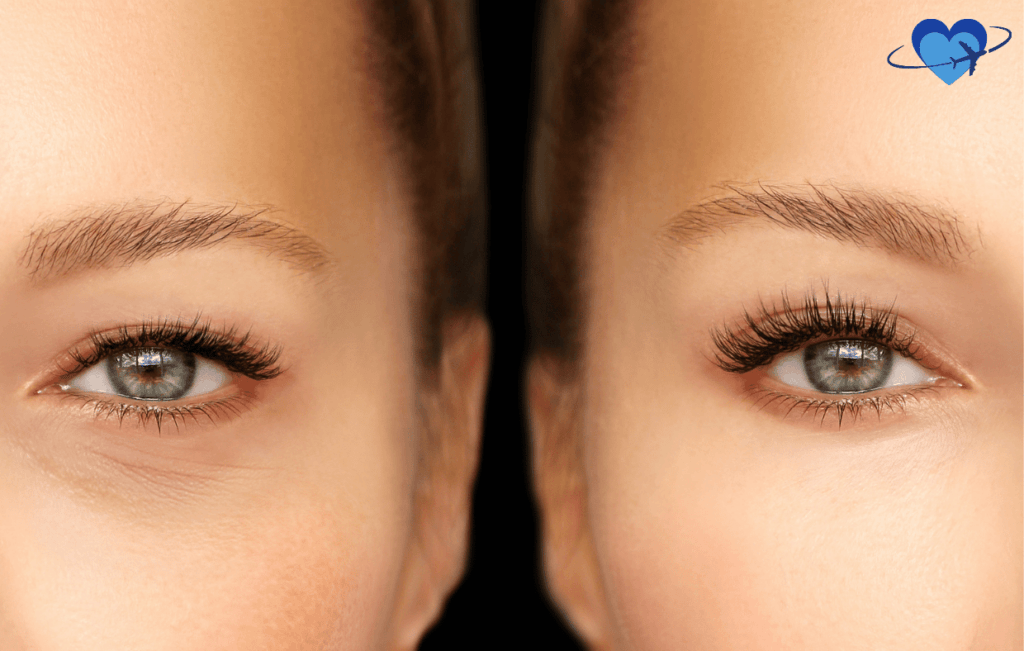
Colombia’s surgeons are often internationally trained, bringing a wealth of experience and expertise in cosmetic surgery, particularly in blepharoplasty. Beyond the medical benefits, patients enjoy Colombia’s vibrant culture and beautiful landscapes, making the recovery process more pleasant. This combination of professional medical care, cost savings, and a welcoming environment positions Colombia as an attractive destination for those seeking to enhance their appearance through an eye lift.
What are the aesthetic enhancements of blepharoplasty?
Blepharoplasty, or eye lift surgery, primarily offers aesthetic enhancements by meticulously removing excess skin, fat, and muscle from the eyelids. This procedure significantly rejuvenates the area around the eyes, making them appear more rested and alert. It effectively addresses concerns such as droopy eyelids and under-eye bags, contributing to a more youthful and vibrant facial appearance.
As a result, patients often report a boost in self-esteem and confidence, directly linked to these aesthetic improvements.
What are the functional improvements of blepharoplasty?
Blepharoplasty can also provide functional improvements. A functional benefit is the enhancement of peripheral vision, which is often compromised by droopy upper eyelids. By excising the excess tissue, the surgery can expand the field of vision, significantly enhancing overall eye functionality. Patients may also experience relief from the discomfort associated with heavy eyelids, including diminished eye strain and improved eyelid mobility.
How do you choose the right surgeon in Colombia?
Choosing the right surgeon in Colombia for an eye lift procedure involves careful consideration of qualifications, experience, and patient feedback. Initially, verify the surgeon’s credentials to ensure they are certified by reputable medical boards. This certification is a fundamental indicator of their expertise in performing blepharoplasty.
Notable boards include the Colombian Society of Plastic, Aesthetic and Reconstructive Surgery (SCCP) and the International Society of Aesthetic Plastic Surgery (ISAPS). Next, assess the surgeon’s experience, specifically in eye lift surgeries, by reviewing their portfolio of before-and-after photos, which provides tangible evidence of their skill and aesthetic judgment. Additionally, seek out patient testimonials and reviews to gauge satisfaction levels and outcomes.
Opting for a surgeon with a proven track record of success and positive patient experiences is crucial. Well-known clinics or surgeons specializing in blepharoplasty may include those with high visibility in medical tourism platforms and those who have received international training or recognition. Finally, a consultation is key to establishing a comfortable rapport, ensuring clear communication about expectations and outcomes.
Importance of certification and experience
When selecting a surgeon for an eye lift in Colombia, the importance of certification and experience is paramount. Certification by a recognized medical board such as the SCCP or ISAPS is a crucial indicator of a surgeon’s commitment to professionalism and expertise in cosmetic surgery. It assures patients that the surgeon has completed rigorous training and adheres to the highest standards of medical practice.
Experience, particularly in performing blepharoplasty, is equally critical. It not only demonstrates the surgeon’s technical proficiency but also their aesthetic sensibility, both of which are essential for achieving the desired outcomes. A surgeon’s extensive experience is often indicative of their ability to manage a broad spectrum of cases, effectively anticipate and address potential complications, and customize the procedure to each patient’s unique needs and expectations.
How is blepharoplasty performed in Colombia?
Blepharoplasty, or eyelid surgery, in Colombia is typically performed as an outpatient procedure, meaning it does not require hospitalization. Here are the key points about how it is performed:
Expertise: Many plastic surgeons in Colombia have extensive experience in performing blepharoplasty and other aesthetic plastic surgery procedures.
Anesthesia: The procedure can be performed under local anesthesia or sedation, depending on the patient’s needs and the surgeon’s preference.
Incisions: For upper blepharoplasty, tiny incisions are made in the eyelid to remove excess skin and sometimes fat. The incisions are carefully placed to minimize visible scarring<.
Procedure Scope: The surgery often focuses on resecting excess skin from the upper eyelids and may also include the removal of fat and muscle if necessary. Lower blepharoplasty involves removing excess skin and fat from the lower eyelids.
What are the pre-operative assessments for blepharoplasty?
Before undergoing blepharoplasty, patients in Colombia undergo comprehensive pre-operative assessments to ensure they are suitable candidates for the surgery. These assessments typically include:
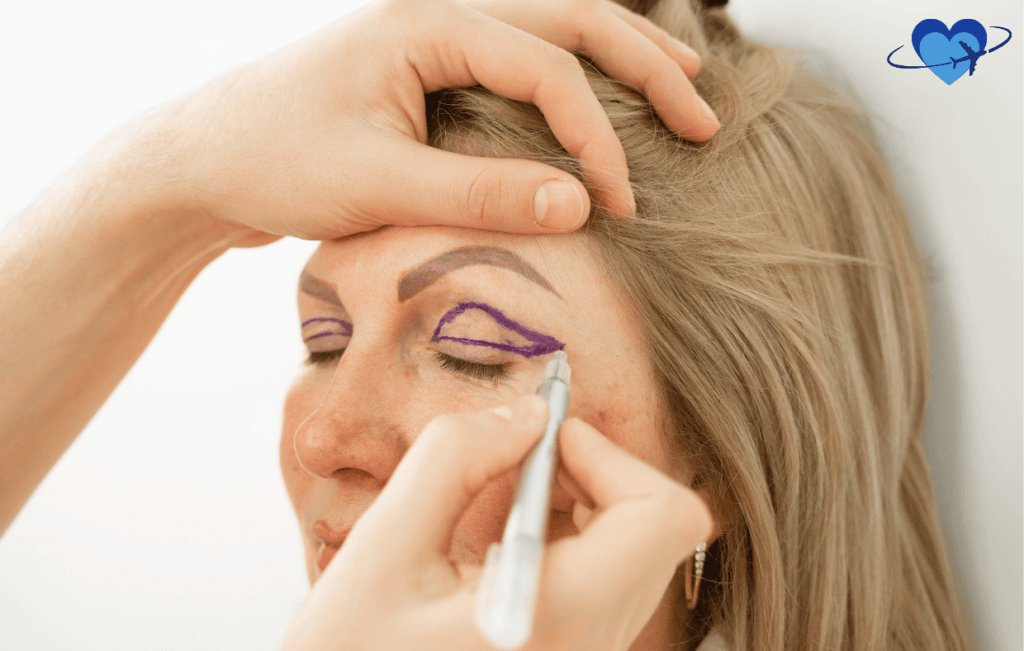
- Medical History Review: To identify any health conditions that could affect the surgery or recovery.
- Physical Examination: Focusing on the eyes and surrounding areas to determine the best surgical approach.
- Vision Tests: To assess the impact of droopy eyelids on peripheral vision.
- Photographic Analysis: High-resolution images are taken for planning purposes and to discuss potential outcomes with the patient.
What are the primary types of blepharoplasty techniques in Colombia?
Surgeons in Colombia utilize a variety of blepharoplasty techniques, tailored to meet the specific needs and goals of each patient. These techniques include:
- Traditional Blepharoplasty: Involves incisions along the eyelid to remove or reposition fat, muscle, and excess skin.
- Transconjunctival Blepharoplasty: Suitable for lower eyelid surgery, this technique involves making an incision inside the eyelid to reduce puffiness and bags without visible scarring.
- Laser-Assisted Blepharoplasty: Uses laser technology to make incisions and remove tissue, offering benefits such as reduced bleeding and quicker recovery times.
What are the anesthesia options for blepharoplasty in Colombia?
Blepharoplasty in Colombia can be performed under various types of anesthesia, depending on the extent of the surgery and the patient’s preference:
- Local Anesthesia with Sedation: Commonly used for blepharoplasty, allowing patients to be comfortable and pain-free while awake.
- General Anesthesia: Recommended for more extensive procedures or patients who prefer to be asleep during the surgery.
What is the step-by-step process of the eye lift surgery?
The blepharoplasty procedure in Colombia typically follows these steps:
- Anesthesia Administration: To ensure the patient’s comfort during the surgery.
- Making the Incision: Depending on the technique, incisions are made in the natural creases of the eyelids or inside the eyelid.
- Removing or Repositioning Tissues: Excess fat, skin, and muscle are carefully removed or re-positioned to achieve the desired contour.
- Closing the Incisions: The incisions are closed with sutures, which may be removed or dissolve on their own over time.
- Recovery: Patients are moved to a recovery area for monitoring before being discharged with post-operative care instructions.
This detailed approach to blepharoplasty in Colombia, combined with the expertise of Colombian surgeons and the use of advanced techniques and technologies, contributes to the high satisfaction rates among patients seeking eyelid surgery in the country.
What is the recovery process for blepharoplasty surgery in Colombia?
The recovery process for blepharoplasty surgery in Colombia typically involves several stages and guidelines to ensure a smooth and effective healing process. Here are the key points:
- Immediate Post-Surgery:
- Return Home: Patients usually return home the same day after surgery.
- Medications: Pain medications are prescribed to alleviate any discomfort.
- Rest: Resting with the head elevated is recommended to minimize swelling.
- Swelling and Bruising: Swelling and bruising are common and usually subside within 1-2 weeks.
- Timing: Stitches are typically removed within 5-7 days.
- Work: Patients can usually return to work after 1 week.
- Final Results: Final results become apparent after 3-6 months.
- Follow Instructions: Adhere to the surgeon’s post-operative instructions to minimize complications.
Immediate post-operative care
Immediately following surgery, patients are provided with detailed care instructions and support from medical staff. Colombian clinics often utilize advanced recovery protocols to minimize discomfort and speed up the healing process. Specific care may include:
- Application of cold compresses to reduce swelling and bruising.
- Prescription of medication to manage pain and prevent infection.
- Guidance on eye care, including cleaning and the use of lubricating eye drops.
What is the expected recovery timeline of an eye lift?
The recovery timeline can vary, but generally follows this pattern:
| Timeframe | Recovery Milestones |
| First 48 hours | Maximum swelling and bruising; use of cold compresses recommended. |
| 1 week | Follow-up visit for suture removal; noticeable reduction in swelling and bruising. |
| 2 weeks | Most patients feel comfortable appearing in public; majority of swelling has subsided. |
| 1 month | Significant improvement in appearance; residual swelling continues to diminish. |
| 3-6 months | Final results become apparent; incision lines continue to fade. |
What recovery really looks like (the stuff they don’t always tell you)
Sure, the timeline table gives you the basics, but here’s what actually happens. First 48 hours? You’ll look like you went ten rounds with Mike Tyson. Bruises will make you grateful for oversized sunglasses, and don’t be surprised if dark circle formation happens even where the surgeon didn’t touch.
Colombian clinics have gotten pretty clever with postoperative care though. They’ll give you these special cooling masks that actually help, not like those useless gel packs from the drugstore. Most places in Bogotá and Medellín have nurses who’ll WhatsApp you daily – seriously, at 2 AM if you need them.
The weird part? Your incisions follow your natural lines so well that after a few months, even you’ll forget where they were. Just don’t expect to look Instagram-ready for at least two weeks. And yeah, you’ll need someone to help you with eye drops because your depth perception gets wonky for a bit.
How do you manage pain and discomfort?
Pain and discomfort are typically mild and well-managed with medications prescribed by the surgeon. Colombian clinics also offer guidance on natural remedies and practices to enhance comfort during recovery, such as:
- Elevating the head while sleeping to reduce swelling.
- Avoiding strenuous activities that may increase blood pressure and swelling.
- Wearing sunglasses to protect the eyes from sunlight and wind.
What are the risks and considerations?
Undergoing blepharoplasty, like any surgical procedure, entails a set of risks and considerations. Potential complications include infection, bleeding, and reaction to anesthesia. Specifically related to eye lift surgery, there is a risk of asymmetry, where the eyelids may not appear uniformly shaped after the surgery.
Some patients might experience dry eyes or difficulty in fully closing their eyes, though these conditions are generally temporary. More serious, but rare, risks involve vision problems, including blurred vision or, in extremely rare cases, vision loss. It is crucial for patients to have a detailed discussion about these risks with their surgeon prior to surgery, ensuring a comprehensive understanding of both the benefits and potential complications of the procedure.
Making an informed decision involves carefully weighing these risks against the anticipated benefits of the surgery. To enhance this section’s relevance and helpfulness, incorporating specific statistics or data on the frequency of complications could provide a clearer perspective for potential patients. For example:
| Complication | Frequency in Colombia* | Management Strategies | Long-term Impact |
| Infection | Less than 1% | Antibiotics and sterile technique | Rarely affects long-term outcome |
| Bleeding | Approximately 2% | Careful hemostasis during surgery, post-op monitoring | Usually resolves without affecting vision |
| Asymmetry | Around 5% | Precise preoperative planning, possible revision surgery | Aesthetic concern, correctable |
| Dry Eyes | Less than 3% | Artificial tears, eye drops | Typically temporary, improves within weeks |
| Vision Problems | Very rare, less than 0.1% | Immediate medical evaluation, may involve further treatment | Rare, but can be serious |
*Note: These figures are illustrative and should be verified with up-to-date and accurate data from reliable medical sources or national health databases in Colombia.
When things don’t go perfectly (because sometimes they don’t)
Look, any surgeon who says they’ve never had complications is lying. The good news? Post-surgical complications from blepharoplasty are usually more annoying than dangerous. But you should know what you’re signing up for.
Sometimes your eyes won’t close completely for a few weeks – yeah, it’s as creepy as it sounds. You might need eye lubricant at night. Some patients get these tiny white bumps called milia along the incision lines. They’re harmless but annoying.
One thing they’re particularly good at in Colombia? Managing complications remotely for international patients. They’ve got protocols for working with your local doctor back home if something needs attention after you leave.
What are common complications for blepharoplasty?
Common complications following blepharoplasty encompass temporary vision disturbances, significant swelling and bruising around the eyes, and persistent dry eyes. Patients may also report sensitivity to light or challenges in fully closing their eyes, though these issues generally resolve with time. Risks of infection and bleeding, while less frequent, are potential concerns.
Moreover, there is a possibility of asymmetry, where the eyelids may not heal uniformly, potentially necessitating further surgical intervention.
What factors affect blepharoplasty surgery success?
The success of blepharoplasty surgery hinges on several pivotal factors. The experience and skill of the surgeon are paramount in achieving aesthetically pleasing outcomes. A patient’s overall health and the condition of their skin, including its elasticity and any existing eye conditions, significantly influence the healing process and the ultimate appearance.
Adherence to pre- and post-operative care instructions is critical for reducing the risk of complications and promoting effective recovery. Furthermore, having realistic expectations regarding the surgery’s results is a key determinant of patient satisfaction.
What results can you expect from blepharoplasty?
From blepharoplasty, patients can expect a noticeable rejuvenation of the eye area, leading to a more rested and alert appearance. The procedure effectively addresses sagging eyelids, removes excess skin, and reduces under-eye bags, significantly improving the overall aesthetic of the eyes. While results vary among individuals, most patients experience a youthful transformation that enhances facial expressions and boosts confidence.
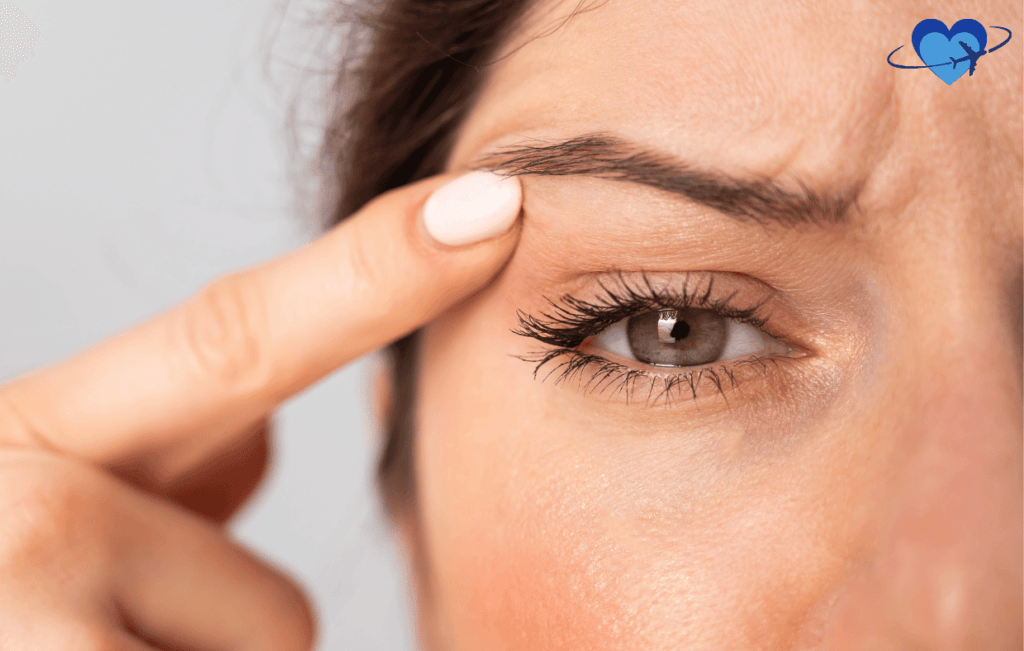
It’s important to note that while the effects of blepharoplasty are long-lasting, they do not halt the aging process. Proper skincare and a healthy lifestyle can help in prolonging the positive outcomes. Patient satisfaction rates are generally high, with many reporting an increase in self-esteem and an improved quality of life post-surgery.
The best compliment after blepharoplasty? “You look so rested!” Not “Did you have work done?” Colombian surgeons have mastered the art of natural-looking results that give you a rejuvenated appearance without the telltale signs of surgery.
This isn’t about chasing youth – it’s about looking like the best version of yourself. Good facial rejuvenation means your friends notice you look great but can’t put their finger on why. Maybe they think you finally started using that expensive eye cream or got more sleep. That’s the goal.
I met a patient from Dallas who had her surgery in Cali. Six months later, her own sister didn’t know she’d had anything done. “I just told everyone I did a juice cleanse,” she laughed. That’s the kind of subtle enhancement Colombian surgeons aim for.
How do you prepare for surgery?
Preparing for surgery involves a series of steps to ensure optimal outcomes and minimize risks. Initially, patients undergo a thorough medical evaluation to assess their health status and identify any conditions that might affect the surgery or recovery. Medications may need to be adjusted, and substances like alcohol and tobacco should be avoided, as they can impede healing.
Patients are also advised to arrange for transportation to and from the surgery center and ensure they have support during the initial recovery period at home. Fasting is often required for several hours before the procedure, depending on the anesthesia used. Following the surgeon’s pre-operative instructions carefully, including guidelines on washing the face and removing makeup, is crucial for preventing infection and promoting a smooth recovery process.
What medical tests are required?
Prior to surgery, a series of medical tests are essential to ensure the patient’s suitability for the procedure. These generally include blood tests to uncover any hidden conditions that could impact the surgery or its recovery phase. For patients with a history of heart problems, cardiac tests may be necessary to evaluate heart health comprehensively.
Additionally, imaging studies of the eye area are often conducted to assist in meticulous surgical planning, aiming for precise corrections and optimal outcomes.
What lifestyle adjustments are necessary?
Making lifestyle adjustments is critical for ensuring a smooth surgical experience and effective recovery. Patients are strongly advised to quit smoking and abstain from alcohol consumption for a specified period before and after the surgery, as these habits can significantly hinder the healing process. It is also recommended to avoid certain medications and supplements known to increase bleeding risk, such as aspirin or ibuprofen, several weeks prior to the procedure.
Embracing healthy eating habits and staying adequately hydrated are encouraged to bolster the body’s ability to heal.
What are the pre-operative instructions?
Pre-operative instructions encompass a variety of guidelines aimed at preparing patients for a successful surgery. It is crucial for patients to fast for at least 8 hours before the procedure, ensuring the stomach is empty to avoid anesthesia-related complications. Cleansing the face with a gentle, non-irritating soap and removing all makeup and creams from the eye area are imperative steps to minimize the risk of infection.
Additionally, patients are guided to arrange their recovery space at home beforehand, making sure essentials are within easy reach and creating a comfortable environment conducive to rest and recuperation.
How much does blepharoplasty cost in Colombia?
The cost of blepharoplasty in Colombia is generally more affordable compared to the United States and Europe, making it an attractive option for many seeking quality cosmetic surgery without the hefty price tag. Prices can vary depending on the complexity of the procedure, the experience of the surgeon, and the specific needs of the patient. Below is a detailed cost breakdown, including the range of prices for different types of blepharoplasty (upper, lower, or both eyelids), and comparing these costs with average prices in the US or Europe.
| Type of Blepharoplasty | Cost in Colombia (USD) | Cost in the US (USD) | Cost in Europe (USD) |
| Upper Eyelid Surgery | $2,000 – $3,000 | $3,000 – $4,500 | $2,500 – $4,000 |
| Lower Eyelid Surgery | $2,800 – $3,500 | $3,500 – $5,500 | $3,000 – $4,500 |
| Both Eyelids | $4,000 – $5,000 | $4,500 – $8,000 | $4,000 – $7,000 |
These costs typically include the surgeon’s fee, facility costs, anesthesia, and post-operative care. However, it’s important for patients to consult with specific clinics or surgeons for precise quotes, as this will provide a clearer understanding of the total investment required. Additionally, patients should consider additional expenses such as travel, accommodation, and any necessary follow-up visits when budgeting for the procedure.
What factors affect the cost of blepharoplasty in Colombia?
The cost of blepharoplasty in Colombia is influenced by several key factors, which are detailed in the table below to provide a comprehensive understanding of what contributes to the overall cost:
| Factor | Impact on Cost |
| Surgeon’s Expertise | Surgeons with extensive experience and a high success rate typically charge more due to their expertise. |
| Complexity of Surgery | More complex cases requiring advanced techniques or additional time can increase the cost. |
| Facility Fees | High-end facilities with state-of-the-art technology may have higher fees. |
| Type of Anesthesia | The choice between local anesthesia with sedation and general anesthesia can affect the cost. |
| Geographic Location | Costs can vary between different cities within Colombia, with major cities possibly being more expensive. |
| Additional Treatments | Combining blepharoplasty with other procedures can raise the overall cost but may be more cost-effective than having them separately. |
| Post-operative Care | Extended aftercare, including follow-up visits and treatments for complications, if any, can add to the cost. |
| Travel and Accommodation | For international patients, travel and accommodation expenses for the duration of the stay in Colombia. |
Understanding these factors can help patients budget more accurately for their surgery and avoid unexpected expenses. It’s advisable for patients to discuss all potential costs with their chosen clinic or surgeon to get a comprehensive overview of the financial investment required for blepharoplasty in Colombia.
How do you select a surgeon in Colombia?
Selecting the right surgeon in Colombia for an eye lift procedure involves a meticulous evaluation of credentials, experience, and patient feedback. It’s crucial to verify the surgeon’s credentials to ensure they are certified by reputable medical boards. In Colombia, surgeons should ideally be certified by the Colombian Society of Plastic, Aesthetic and Reconstructive Surgery (SCCP) or have international certifications such as from the American Board of Plastic Surgery (ABPS).
To assist in this process, consider using online databases or contacting medical institutions directly for verification. The Colombian Ministry of Health and Social Protection provides a database where you can verify the licensure and specialties of healthcare professionals. Next, assess the surgeon’s experience, specifically in eye lift surgeries, by reviewing their portfolio of before-and-after photos.
This provides tangible evidence of their skill and aesthetic judgment. Additionally, seek out patient testimonials and reviews on healthcare review platforms and social media to gauge satisfaction levels and outcomes. Opting for a surgeon with a proven track record of success and positive patient experiences is crucial.
Finally, a consultation is important to establishing a comfortable rapport, ensuring clear communication about expectations and outcomes. This comprehensive approach ensures that you select a surgeon in Colombia who aligns with your aesthetic goals and health considerations, ultimately contributing to a successful eye lift experience.
Checklist for evaluating a surgeon’s qualifications and experience
When evaluating a surgeon’s qualifications and experience for blepharoplasty in Colombia, the following checklist can be utilized, presented in a detailed markdown table format:
| Criteria | Description | Importance | Details for Colombia |
| Board Certification | Verify if the surgeon is certified by recognized medical boards. | Essential | Look for certification by the SCCP or international boards like the ABPS. |
| Specialization in Blepharoplasty | Surgeons who specialize in eyelid surgery often have higher proficiency. | Highly Recommended | Inquire about the surgeon’s specific training and number of blepharoplasty procedures performed. |
| Years of Experience | The duration of the surgeon’s practice, especially in performing blepharoplasty. | Critical | Experienced surgeons are likely to have dealt with a wide range of cases and complications. |
| Before-and-After Photos | Review the surgeon’s portfolio to evaluate their capability in achieving aesthetically pleasing results. | Very Helpful | Assess the naturalness of the results and the surgeon’s aesthetic style. |
| Patient Testimonials | Testimonials from former patients provide insights into satisfaction levels and patient care. | Informative | Look for testimonials on the surgeon’s website, healthcare review platforms, and social media. |
| Professional Affiliations | Membership in respected cosmetic surgery organizations indicates adherence to high practice standards. | Beneficial | Confirm affiliations with organizations like the SCCP, ISAPS, or other international cosmetic surgery societies. |
| Consultation Process | The consultation should offer a comprehensive discussion of aesthetic goals and achievable results. | Necessary | A detailed consultation helps ensure clear communication and alignment of expectations. |
| Safety and Facility Standards | The surgical procedures should be conducted in facilities that uphold accredited safety standards. | Mandatory | Verify that the clinic or hospital meets national and international safety standards for cosmetic surgery. |
This exhaustive checklist ensures a thorough evaluation of potential surgeons in Colombia, aiding in the selection of a professional who best meets the patient’s needs and expectations for blepharoplasty.
How do you travel to Colombia for surgery?
Traveling to Colombia for surgery involves careful planning to ensure a smooth and stress-free experience. The process starts with researching and selecting a reputable clinic or surgeon, followed by scheduling a consultation to discuss the procedure, recovery, and any necessary pre-operative assessments. Once the surgery is booked, arranging travel and accommodation near the medical facility becomes crucial for convenience and comfort.
International patients should check visa requirements and ensure their passport is valid for the duration of their stay. It’s also advisable to purchase travel insurance that covers medical treatment abroad, offering protection against unexpected medical expenses. Preparing for the recovery period by planning for adequate rest and arranging for assistance, if needed, is essential.
Finally, communicating with the chosen medical facility about arrival and any pre-surgery instructions will help align all preparations for the surgery. To enhance the usefulness of this section, consider the following table format to include specifics about common entry points, visa requirements, and assistance services:
| Aspect | Details |
| Major Airports | – El Dorado International Airport (Bogotá)- José María Córdova International Airport (Medellín)- Rafael Núñez International Airport (Cartagena) |
| Visa Requirements | – Most travelers from the US, Canada, and EU countries do not require a visa for stays up to 90 days.- Check the Colombian Embassy website for the latest visa information. |
| Medical Tourism Assistance Services | – Many clinics offer assistance with travel arrangements, including airport transfers and accommodation.- Services may also include language translation and help with medical documentation. |
| Travel Insurance | – Highly recommended for all medical tourists.- Ensure the policy covers medical treatments and any potential travel disruptions. |
| Preparation for Recovery | – Arrange for accommodation with easy access to medical care.- Consider staying near the clinic/hospital for the initial recovery phase. |
This detailed approach to planning your travel to Colombia for surgery ensures that every aspect of your medical journey is considered, from arrival to recovery, making the entire process as seamless and comfortable as possible.
Are there patient testimonials?
Yes, patient testimonials are widely available and serve as a valuable resource for individuals considering blepharoplasty in Colombia. These testimonials often provide insight into personal experiences, covering the entire process from initial consultation through to recovery and results. Many clinics and surgeons feature patient testimonials on their websites, and additional feedback can be found on healthcare review platforms and social media.
Reading or listening to these testimonials allows prospective patients to gauge satisfaction levels, understand potential outcomes, and set realistic expectations. Furthermore, they can offer comfort and reassurance by highlighting positive experiences and successful surgeries, making them an essential consideration when researching and selecting a surgeon or medical facility in Colombia.
Success stories and personal experiences
Success stories and personal experiences from patients who have undergone blepharoplasty in Colombia are invaluable for those considering the procedure. These accounts often detail the journey from pre-surgery apprehensions to post-surgery fulfillment, showcasing the emotional and physical transformation experienced. Shared through clinic websites, social media, and online forums, these narratives provide insights into the quality of care, the professionalism of the medical staff, and the overall patient experience.
For individuals contemplating blepharoplasty, reading these testimonials can be instrumental in setting realistic expectations and understanding the potential life-changing impact of the surgery.
Before-and-after photos of blepharoplasty in Colombia
Before-and-after photos serve as a compelling visual aid to understand the potential outcomes of blepharoplasty. Surgeons and clinics in Colombia frequently display these photos, illustrating the transformative effects of their work. These images are not just a testament to a surgeon’s skill but also assist patients in making informed decisions by providing tangible visual references of actual results.
Prospective patients can evaluate the aesthetic achievements of others with similar facial features and concerns, helping them choose a surgeon whose artistic vision and technical proficiency match their desired objectives.
Frequently asked questions about blepharoplasty in Colombia
When considering blepharoplasty in Colombia, several frequently asked questions arise, reflecting the common concerns and curiosities among prospective patients. Here, we address these queries with specifics about the Colombian context, such as average recovery times based on local patient data and specific qualifications held by Colombian surgeons, to enhance the section’s helpfulness.
What is the difference between an eye lift and blepharoplasty?
Both terms refer to the same cosmetic procedure aimed at rejuvenating the eyelids by removing excess skin, muscle, and sometimes fat. “Eye lift” is more commonly used in everyday language, while “blepharoplasty” is the medical term.
How much does blepharoplasty cost in Colombia?
The cost is generally more affordable compared to the United States and Europe. Prices vary based on the procedure’s complexity, the surgeon’s experience, and the patient’s specific needs. Here’s a detailed cost breakdown:
| Type of Blepharoplasty | Cost in Colombia (USD) | Average Cost in the US (USD) | Average Cost in Europe (USD) |
| Upper Eyelid Surgery | $1,500 – $3,000 | $3,000 – $4,500 | $2,500 – $4,000 |
| Lower Eyelid Surgery | $1,800 – $3,500 | $3,500 – $5,500 | $3,000 – $4,500 |
| Both Eyelids | $2,500 – $5,000 | $4,500 – $8,000 | $4,000 – $7,000 |
What types of cosmetic surgery is Colombia known for?
Beyond blepharoplasty, Colombia is renowned for excellence in liposuction, breast augmentation, and rhinoplasty, attracting patients globally for its high-quality yet affordable surgical options.
What are the qualifications of surgeons performing blepharoplasty in Colombia?
Surgeons in Colombia are often internationally trained and certified, with many holding certifications from the Colombian Society of Plastic, Aesthetic and Reconstructive Surgery (SCCP) or the American Board of Plastic Surgery (ABPS).
How long does recovery from blepharoplasty surgery take in Colombia?
Most patients can resume normal activities within two weeks, although complete healing and the full effects of the surgery may take up to several months. Recovery times can vary based on individual healing processes and the extent of the surgery.
What are the risks associated with undergoing blepharoplasty in Colombia?
Risks include infection, bleeding, reaction to anesthesia, and asymmetry. However, complications are rare, and surgeons in Colombia follow stringent protocols to minimize risks.
What are the risks associated with undergoing blepharoplasty in Colombia?
Abdominoplasty in Colombia is significantly less expensive than in countries like the United States, Canada, and many European nations, without compromising on the quality of care. This cost efficiency, combined with Colombia’s reputation for excellent healthcare, makes it an attractive option for those seeking affordable cosmetic surgery solutions.
What should patients expect in terms of results from blepharoplasty surgery in Colombia?
Patients can expect a noticeable rejuvenation of the eye area, with a more rested and alert appearance. Results vary among individuals, but most patients experience a youthful transformation that enhances facial expressions and boosts confidence.

